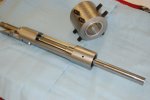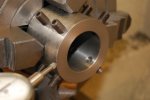Hi,
I've been using one of those big aluminum ones from Viper's Benchrest.
I am thinking about making a shorter one, with the screws offset to work in between the jaws of my four jaw chucks. I've determine it needs to be at least 4.5" long so I can grab the action on the front and back of the magazine and ejection port cut outs. I have a piece of 304 Stainless steel tubing, it has 1/4" thick walls. inside diameter is 1.7" Do you think this would work?
Thanks,
Bill
I've been using one of those big aluminum ones from Viper's Benchrest.
I am thinking about making a shorter one, with the screws offset to work in between the jaws of my four jaw chucks. I've determine it needs to be at least 4.5" long so I can grab the action on the front and back of the magazine and ejection port cut outs. I have a piece of 304 Stainless steel tubing, it has 1/4" thick walls. inside diameter is 1.7" Do you think this would work?
Thanks,
Bill
Last edited:







